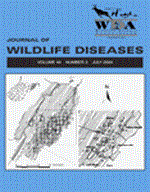Packed cell volumes (PCVs) and plasma chemistry parameters were measured in 15 adult and 18 nestling African fish eagles (Haliaeetus vocifer) sampled from June 2002 through January 2003 in Uganda. Morphologic measurements were obtained from 15 adult eagles. All eagles were examined for blood parasites and sexed by examination of DNA from red blood cells. Ten adults and eight nestlings were sampled from Lake Mburo and five adults and 10 nestlings were sampled from Lake Victoria near Entebbe, Uganda. Analysis of variance was conducted to assess the association between site, age, sex, and plasma chemistry parameters and the association between sex and morphologic characteristics. Plasma chemistry values for nestling and adult African fish eagles were similar to those reported for other captive and free-ranging eagle species. Packed cell volumes for nestling African fish eagles were markedly lower than values reported for nestlings of other eagle species, although the mean estimated age of nestlings sampled also was lower. A significant association (P≤0.05) was found between PCV of nestling eagles and study site (lower at Lake Mburo) but no association was found between PCV and nestling body weight (P≥0.05). An unidentified Plasmodium sp. was present in erythrocytes of three nestlings from Lake Mburo. No other blood parasites were seen. There was significant variation (P≤0.05) in PCV, calcium, phosphorous, potassium, cholesterol concentrations, and creatine kinase activity between adults and nestlings; all were lower in adults. Aspartate transaminase activity was higher in adults. Like other Haliaeetus sp., body weight, bill depth, culmen length, footpad length, and hallux length as well as bill depth measurements were significantly (P≤0.05) greater for females than males. The objective of the study was to provide baseline biologic and physiologic information that may prove useful in the management and study of captive and wild populations of African fish eagles.
How to translate text using browser tools
1 July 2004
CLINICAL PATHOLOGY AND MORPHOMETRICS OF AFRICAN FISH EAGLES IN UGANDA
Simon Hollamby,
Josephine Afema-Azikuru,
James G. Sikarskie,
John B. Kaneene,
John N. Stuht,
Scott D. Fitzgerald,
William W. Bowerman,
Kenneth Cameron,
A. Rae Gandolf,
Gretchen N. Hui,
Christine Dranzoa,
Wilson K. Rumbeiha

Journal of Wildlife Diseases
Vol. 40 • No. 3
July 2004
Vol. 40 • No. 3
July 2004
African Fish Eagle
blood parasites
Haliaeetus vocifer
Morphometrics
packed cell volume
plasma chemistry
Plasmodium




